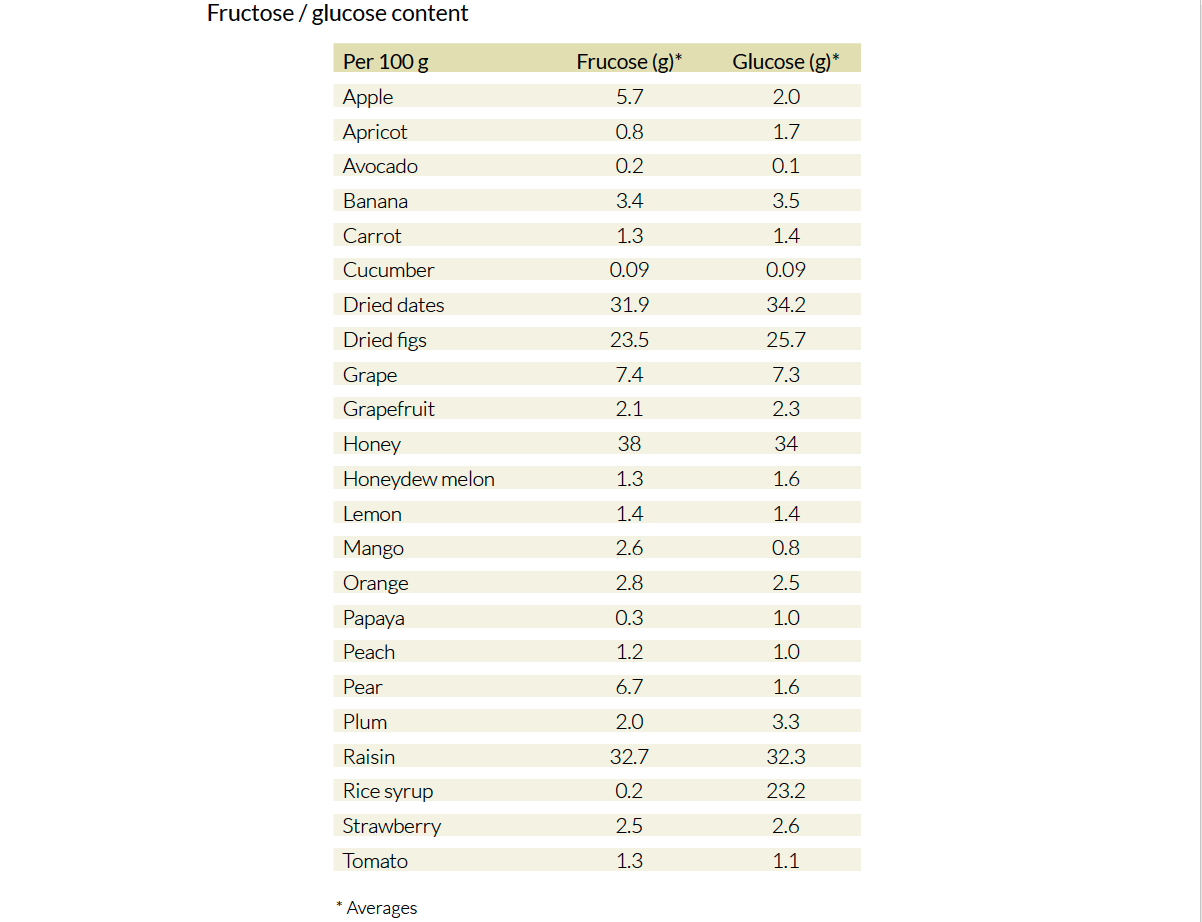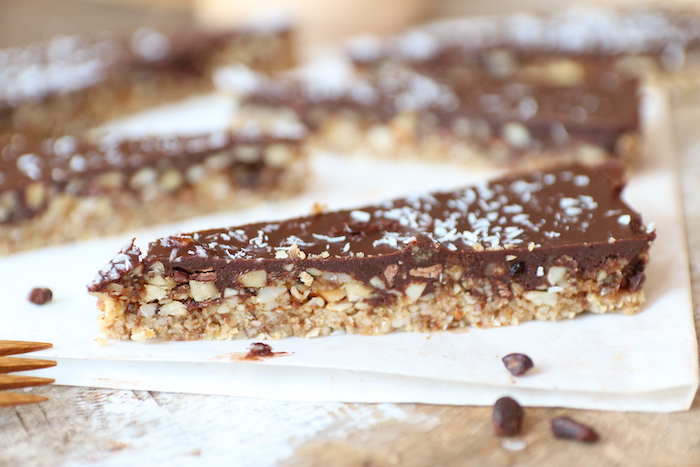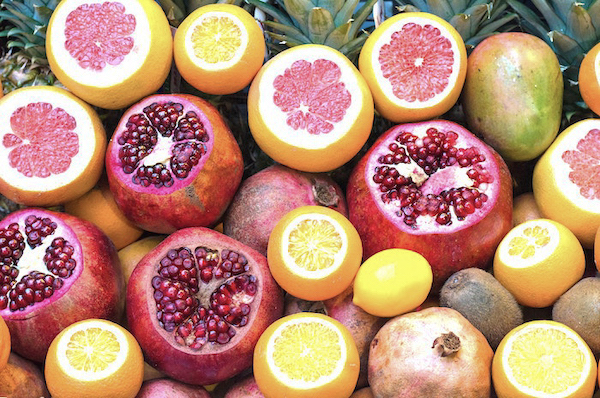Anyone who has studied the subject of fructose is justified in asking the question: How does the 80/10/10 diet work? If not done in the right way, eating too much fructose can lead to numerous physical complaints. Let’s take a closer look at this topic now.
What’s behind the 80/10/10 diet?
80/10/10 is a diet program developed by Dr. Douglas Graham. Based on what’s known as the “Natural Health Diet,” Douglas Graham described in his book “The 80/10/10 High Carb Diet” his reasons for following a raw vegan, low-fat diet that consists mostly of ripe fruit.
The 80/10/10 formula represents the ratio of amount of carbohydrates, protein, and fat. Dr. Graham relates this to the calorie-nutrient ratio. According to this, 80% of calories should come from carbohydrates, ideally from whole fruits, and then a maximum of 10% from protein and 10% from fat. By comparison, nutritional science in general tends to recommend a ratio of 55% carbohydrate, 15% protein and 30% fat.
Three decades of intensive research and advice to health-conscious people and professional athletes showed Dr. Graham that this type of diet makes it possible to have consistently high energy, and an ideal weight.
This thesis is supported by the longevity studies of John Robins. In his research, he found that, on average, healthy older people eat a diet that is 75% carbohydrates, 15% fat and 10% protein, consuming up to 1,800 calories per day. In this sense, eating in moderation and exercising regularly are important ways to complement healthy aging.
Carbohydrates provide the best fuel
Depending on the number of sugar molecules, carbohydrates are divided into three groups:
• Simple sugars (glucose, fructose, galactose)
• Double sugars (household sugar, malt sugar, lactose)
• Multiple sugars (starch, dietary
Before our cells can use food as fuel, it first has to be broken down into simple sugars. Multiple and double sugars are broken down into single sugars, and only the pure glucose passes into the blood and supplies the cells with energy. We’ve described everything important about fructose in the article “Is fructose unhealthy?”
It’s important to understand the difference between industrially processed sugar and the type of sugar in fruit. Industrially processed sugar has no nutritional value and actually tends to consume nutrients when metabolized. Fruits, on the other hand, are naturally high-quality nutrient packages in a natural complex of active ingredients. Our bodies can digest them almost completely, which makes them an ideal fuel or energy source for us as humans.
Dr. Graham doesn’t think too highly of dietary supplements. He points out that so far only 10% of all existing nutrients (including phytonutrients) have been discovered or identified. Given this fact, we can’t really discuss nutrient deficiency. He believes that a natural plant-based diet has an ingenious balance of nutrients, and suspects that taking isolated and compounded individual nutrients, and making them a regular part of your diet is more likely to create an imbalance.

Fuits and blood sugar
Dr. Graham also refutes the assumption that eating fruit will cause blood sugar problems. A primarily fruit-based diet that includes lots of fresh, sweet fruits does not actually cause high blood sugar, at least not while practicing a low-fat, raw vegan diet.
It’s best to eat fruit as naturally as possible. The fructose in dried fruit is raised to unnatural levels through the process of being dehydrated. Even freshly squeezed fruit juices should also be consumed in moderation, since the fiber in the fruit is what slows the sugar absorption into the body.
The soft, water-soluble fiber in fruits helps to make sure that sugar is absorbed slowly and gradually, so that there are no rapid blood sugar spikes happening as a result.
The following overview shows the fructose/glucose ratio of various fruits (researched by “Your Nutrition”):

It has now been confirmed by many doctors and different studies that a high-fat diet combined with carbohydrates in particular promotes the development of type 2 diabetes (1).
Fruits eaten whole or in simple combinations naturally increase blood glucose levels for a short period of time. Eating raw, ripe fruit leads to a sustained elevated blood glucose level, but only if you’re simultaneously eating a high-fat diet.
The recommendation to avoid fruit altogether and instead eat complex carbohydrates combined with fat has been consistently refuted. Simple carbohydrates together with fat are particularly dangerous.

Too much fat is harmful
It’s the fat that leads to blood sugar problems, not the fruit. The mechanism that triggers the rise in blood sugar levels can be simply explained:
Carbohydrates can pass through the wall of the small intestine and into the blood as glucose, and from there they enter our cells with the help of insulin.
Excessive fat disrupts this whole process, because it leads to a buildup of sugar in the blood: if we eat a diet that’s too rich in fat, a film of fat starts to form on the blood vessel walls, which house the cell’s insulin receptors. As a result, insulin isn’t able to properly dock at the receptors. This means that the cells do not receive the “door-opening signal,” and the blood glucose level stays too high. The consequences are an overworked pancreas, insulin resistance, and blood sugar-related metabolic diseases.
Excess fat also displaces oxygen in the blood. A lack of oxygen is what activates the adrenal glands to produce adrenaline. High adrenaline levels coupled with stress are fairly typical of Western lifestyles. In the long term, this can create fatigued adrenal glands, resulting in “chronic fatigue” in the body.
Fats take a lot more time to reach the cells than carbohydrates
They linger in the stomach, small intestine, and lymphatic system for several hours until they get absorbed into the bloodstream. Additionally, long-chain fatty acids then stay trapped in the bloodstream longer than glucose normally would.
As a result, in a high-fat diet, the blood permanently has too much fat in it, since there’s always fat lingering from the previous meal.
Conclusion: If fruit is eaten without fat, the glucose quickly moves through the small intestine into the bloodstream, and into the cells where it’s actually needed.
Are you interested in gaining a comprehensive understanding of the health benefits of a plant-based diet? Download the curriculum for our Holistic Nutrition Coach training program.
Dr. Graham also looks at the issues of fruit and candida, cancer, and tooth decay:
-
Fruit and Candida
Candida albicans, a yeast of the Candida group, feeds on sugar and is found on the skin and mucous membranes. When the blood sugar level is within a normal range, this keeps the Candida colony at a normal size. But if the environment is out of balance and the blood sugar level is permanently too high, the Candida organisms respond by multiplying. Strictly speaking, the Candida yeasts can actually be viewed as helpers, because they virtually support the breakdown of blood sugar, which supports the pancreas. And this imbalance could be fixed almost instantly if dietary rules are followed, since Candida microbes have a short life span.
-
Does fruit feed cancer cells?
The question of whether fruit consumption is beneficial or harmful to a cancer diagnosis is the subject of quite a lot of controversy.
Dr. Graham points out in his book that cancer cells especially thrive in an anaerobic environment, or rather, where oxygen levels are very low. A high-fat diet lowers blood oxygen levels and creates an ideal environment for cancer cells to multiply. A low-fat, high-fruit diet, on the other hand, supports an oxygen-rich and alkaline environment.
-
Fruit and cavities
The key to healthy teeth is also the key to thriving health in general, according to a statement by Douglas Graham. Of course, you shouldn’t just eat citrus fruits all day, but basically, raw fruits and vegetables are the best kind of food for your teeth.
Ideally, the acid level of the mouth is always at a slightly alkaline level. Because of this, acid-forming foods and stress are not ideal for this environment. Graham also calls dried fruit “anything but good” for our teeth. Dried fruits are extremely sticky and like to get stuck to the teeth and in the spaces between them until they are broken down by bacteria that form acidic metabolic waste products.
Note: A fruit-based diet should be balanced by mineral-rich leafy greens and vegetables (see “Final Consideration” below).

How much protein do we really need?
Proteins are complex molecular compounds composed of amino acids. They are generally considered to be the basic building blocks of all life.
Dr. Graham sees the danger more in consuming too much protein, and less in consuming too little. Bodybuilders following the 80/10/10 program have noticed that their protein needs decrease dramatically and both their energy and muscle growth increase when they get enough calories in the form of carbohydrates.
All plant foods contain protein (fruits between 4 to 8% and vegetables between 10 to 30%) and it’s no coincidence that fruits and vegetables contain just the right amount of protein for our bodies.
10% means that with a daily intake of 1800 calories, a person’s diet should contain 180 calories worth of protein, or 45 g. The recommendation of the GNS is 50 to 70 g depending on body weight.
Furthermore, protein from our diet is not the only source for building the proteins we need. In fact, our bodies “recycle” between 100 to 300 grams of our body’s own proteins very effectively every day. And we can help this process of “autophagy” to be even more effective by practicing “Intermittent Fasting“.
A high protein diet, on the other hand, is actually associated with a lot of different health problems. Protein-based foods all have an acid-forming effect and promote the buildup of deposits on the walls of blood vessels. To stay in balance, the body needs valuable base-forming minerals like calcium and magnesium to neutralize acids and make them “excretable.”

What can an 80/10/10 daily routine look like?
Here is an example of a meal plan to give you an idea of your daily diet.
Breakfast
The first meal could be a freshly squeezed green juice and 2 lbs. of mangos.
Lunch
The second meal could be 1 ibs. of bananas and 1 Ibs. of apricots
Dinner
The big salad prepared with half an avocado and a dressing of nuts and seeds.
Healthy benefits:
- Fruits provides our organism with plenty of carbohydrates and enzyme-rich plant cell water which supports the lymphatic system and cleanses our metabolic system.
- The perfect complement to activating the lymphatic system is exercise and sport.
- Greens provide chlorophyll and minerals.
Final consideration
In the article “Is fructose healthy?“, we discussed in detail the physical effects of high fructose consumption, like obesity, elevated blood lipid levels, or nonalcoholic fatty liver. Dr. Graham comprehensively debunks concerns about how a diet high in fructose and fruit can work from these standpoints, and he shows that fats in particular are causative factors in metabolic disorders and persistently high blood sugar levels.
Find “Your Nutrition“
To all those who have difficulty finding their way among the many different nutritional approaches, we recommend that you don’t just blindly adopt a nutritional theory, but always ask yourself the question: What is right for my body at this point in time?
It’s worth noting that the 80/10/10 diet has a lot in common with the nutritional approaches of Arnold Ehret and Anthony William. And the therapy approaches according to Dr. John Switzer and Brian Clement provide valuable additions:
The mucus-free diet according to Arnold Ehret
The German naturopath Arnold Ehret sees physical symptoms as a blockage of the human body’s conduction system and thus the body’s attempt to get rid of waste products and mucus. At the beginning of the 19th century, as a result of extensive personal experience, he founded the mucus-free diet.
He views a low-protein, low-fat, and alkaline-forming diet, as well as regular fasting phases, as the chance to make up for the consequences of malnutrition and overeating.
Nutrition according to Anthony William
Anthony William tirelessly encourages his readers and listeners to bring the vital power of nature’s bounty into our lives in delicious and joyful ways, and gives hope to many people by explaining why fruits and vegetables are more potent as remedies than any medicine could be. Keeping in mind that fats stress the liver and block excretory processes, Anthony William has developed the Fat-Free Liver Relief Morning and Liver Rescue 3-6-9.
Wild Plants Vital Diet according to Dr. John Switzer
Dr. Switzer developed the Wild Plants Vital Diet Therapy with the background that fruits today are much higher in sugar as a result of over-breeding. Some essential elements of this therapy are wild plants and fermented juices, which provide a large amount of minerals and phytonutrients.
Nutrition according to the Hippocrates Health Institute
Dr. Brian Clement, the director of the Hippocrates Health Institute, is an advocate of the low-fruit and sprout-rich diet. In particular, he emphasizes wheatgrass juice, sprouts, and greens for their richness in enzymes and minerals.
Conclusion:
• The high-protein diet has an acid-forming effect and promotes deposits in the blood vessels and connective tissue.
• The high-fat diet slows down metabolic, detoxification, and elimination processes, decreases the oxygen saturation in the blood, and increases the risk of high blood sugar, blood fat levels, and their secondary diseas
Consequently, the rather low-fat and low-protein, raw vegan diet is a legitimate recommendation:
The liver, our most important detoxification organ, is the most active between 1 and 3 o’clock, and works until the early morning. The liver receives the best support by drinking a lot of water after waking up, and also by a fat-free or low-fat morning. This allows the liver to complete all the important tasks necessary for getting rid of the breakdown products.
When eating a diet rich in fruits, the following should be taken into account:
Since nowadays almost all fruits are overgrown and contain more sugar than they did a few years ago, and much more than wild fruits, it’s important to also include plenty of minerals and bitter substances in the daily diet:
• Vegetables and leafy greens are rich in minerals; the darker green they are, the better.
• From spring to fall, wild plants provide important minerals and phytonutrients.
• Sprouts and greens can ideally supplement our nutrient needs from fall to spring.
Fructose consumption should also be considered in the context of overall lifestyle: People who exercise or get in a lot of physical activity are able to tolerate more fructose than people who do little physical activity and have lower energy needs.
Would you like to join our unique, based on nutritional sciences and practice-oriented training program for gaining a high level of health?
We are more than happy to inform you about our training program on our website!





0 Comments